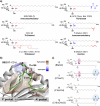Development of potential immunomodulatory ligands targeting natural killer T cells inspired by gut symbiont-derived glycolipids
- PMID: 40169880
- PMCID: PMC11961698
- DOI: 10.1038/s42004-025-01497-z
Development of potential immunomodulatory ligands targeting natural killer T cells inspired by gut symbiont-derived glycolipids
Abstract
α-Galactosylceramide (α-GalCer) is a prototypical antigen recognized by natural killer T (NKT) cells, a subset of T cells crucial for immune regulation. Despite its significance, the complex structure-activity relationship of α-GalCer and its analogs remains poorly understood, particularly in defining the structural determinants of NKT cell responses. In this study, we designed and synthesized potential immunomodulatory ligands targeting NKT cells, inspired by glycolipids derived from the gut symbiont Bacteroides fragilis. A series of α-GalCer analogs with terminal iso-branched sphinganine backbones was developed through rational modification of the acyl chain. Our results identified the C3' hydroxyl group as a structural element that impairs glycolipid presentation by CD1d, as evidenced by reduced IL-2 secretion and weak competition with a potent CD1d ligand. Notably, among C3'-deoxy α-GalCer analogs, those containing an α-chloroacetamide group exhibited robust NKT cell activation with Th2 selectivity. Computational docking and mass spectrometry analyses further confirmed the substantial interaction of α-chloroacetamide analogs to CD1d. These findings underscore the potential of leveraging microbiota-derived glycolipid structures to selectively modulate NKT cell functions for therapeutic purposes.
© 2025. The Author(s).
Conflict of interest statement
Competing interests: The authors declare no competing interests.
Figures






References
-
- Brennan, P. J., Brigl, M. & Brenner, M. B. Invariant natural killer T cells: an innate activation scheme linked to diverse effector functions. Nat. Rev. Immunol.13, 101–117 (2013). - PubMed
-
- Bendelac, A., Savage, P. B. & Teyton, L. The biology of NKT cells. Annu. Rev. Immunol.25, 297–336 (2007). - PubMed
-
- Borg, N. A. et al. CD1d-lipid-antigen recognition by the semi-invariant NKT T-cell receptor. Nature448, 44–49 (2007). - PubMed
-
- Zhou, D. et al. Lysosomal glycosphingolipid recognition by NKT cells. Science306, 1786–1789 (2004). - PubMed
Grants and funding
LinkOut - more resources
Full Text Sources
Miscellaneous

